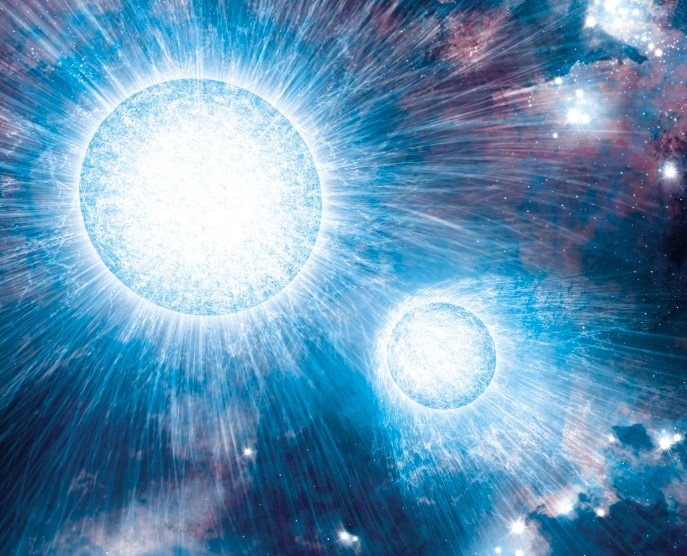An international team led by Tomer Shenar from Tel Aviv University has uncovered that most massive stars in the early universe likely formed in pairs. Published in Nature Astronomy on September 2, 2025, the research analyzed stars in the Small Magellanic Cloud and found over 70 percent have close companions, reshaping our view of star formation billions of years ago.
This breakthrough came from using the Very Large Telescope in Chile to study nearly 1,000 massive stars in a low metal environment similar to the young cosmos. The findings suggest binary systems were common even then, influencing how stars evolve and create black holes.

Groundbreaking Research on Star Pairs
Scientists focused on the Small Magellanic Cloud, a nearby galaxy with low metal content that mirrors conditions right after the Big Bang. They monitored 139 massive stars over three months to track their movements and companions.
The team discovered that these hefty stars rarely form alone. In fact, the high rate of binaries challenges old ideas that low metal settings might lead to more solo stars.
This work builds on earlier studies of Milky Way stars, where binaries are also frequent. By comparing data, researchers confirmed patterns hold across different galaxies.
Experts say this could explain why we detect gravitational waves from merging black holes today. Those events often trace back to paired massive stars that collapsed together.
How the Study Was Conducted
The research relied on advanced tools like the FLAMES instrument on the Very Large Telescope. Astronomers collected light spectra to measure star speeds and detect orbital pulls from hidden partners.
They observed stars with masses over eight times the sun’s, focusing on close binaries where stars orbit each other tightly.
Data showed clear velocity shifts in most cases, pointing to companions. The team plans 16 more observation rounds to map orbits and masses fully.
This method provides the strongest evidence yet for binary formation in metal poor zones. It involved 70 astronomers from around the world, ensuring robust analysis.
Key Findings from the Small Magellanic Cloud
The Small Magellanic Cloud offered a perfect lab due to its similarity to the early universe. Here are some standout results:
- Over 70 percent of massive stars have a close partner, higher than some previous estimates.
- Binary systems likely formed early, affecting star life cycles and supernova events.
- These pairs could lead to more black hole mergers, detectable by tools like LIGO.
Researchers noted that low metals do not reduce binary rates, contrary to some theories. This aligns with 2025 data from other galaxies, where binaries drive cosmic evolution.
The study also measured star properties like temperature and brightness. These details help model how pairs interact over time.
Implications for Black Holes and Gravitational Waves
Paired massive stars often end as black holes that merge, sending ripples through space. The new findings suggest this happened more in the young universe than thought.
This ties into recent detections by gravitational wave observatories. In 2025 alone, several mergers were linked to ancient binary stars.
Cosmologists now have better tools to simulate early star formation. Understanding binaries helps predict galaxy growth and element spread.
The research echoes a 2024 study on Milky Way binaries, showing universal patterns. It could refine models for future telescopes like the James Webb Space Telescope.
Comparing Binary Star Systems Across Galaxies
To highlight differences and similarities, here’s a simple table of binary fractions in various settings based on recent studies:
| Galaxy or Environment | Estimated Binary Fraction for Massive Stars | Key Notes |
|---|---|---|
| Milky Way (high metal) | 60-70% | Common in our galaxy, influences star clusters. |
| Small Magellanic Cloud (low metal) | Over 70% | Mirrors early universe, high pair rate confirmed in 2025. |
| Large Magellanic Cloud | 50-60% | Slightly higher metals, binaries still prevalent. |
| Early Universe Simulation | 70-80% | Based on models, pairs boosted black hole formation. |
This table shows binaries are a rule, not an exception, across cosmic history.
What Experts Are Saying
Reactions poured in after the publication. One astronomer called it a game changer for understanding the first stars.
Co author Julia Bodensteiner noted the excitement of linking these pairs to black hole origins. The team aims to expand observations to other low metal galaxies.
This builds on 2025 trends in astrophysics, like new data from the Gaia spacecraft on nearby binaries. It sparks debates on how metals affect star births.
Public interest spiked with social media buzz, tying the study to questions about alien life in binary systems.
Future Directions in Star Research
The team secured time for more telescope runs to detail companion types. This could reveal if some pairs include neutron stars or other oddities.
Broader impacts include better predictions for supernova rates in young galaxies. Researchers hope to inspire new simulations of cosmic dawn.
As 2025 unfolds, this work sets the stage for discoveries with upcoming missions. It reminds us how connected stars shape the universe we see today.
Share your thoughts on this cosmic pairing in the comments below, and spread the word to fellow space enthusiasts.
